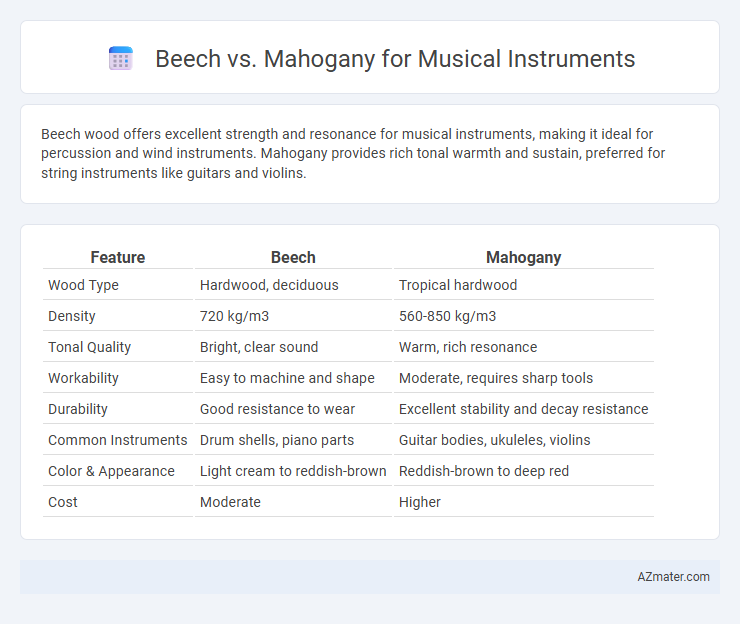Beech wood offers excellent strength and resonance for musical instruments, making it ideal for percussion and wind instruments. Mahogany provides rich tonal warmth and sustain, preferred for string instruments like guitars and violins.
Table of Comparison
| Feature | Beech | Mahogany |
|---|---|---|
| Wood Type | Hardwood, deciduous | Tropical hardwood |
| Density | 720 kg/m3 | 560-850 kg/m3 |
| Tonal Quality | Bright, clear sound | Warm, rich resonance |
| Workability | Easy to machine and shape | Moderate, requires sharp tools |
| Durability | Good resistance to wear | Excellent stability and decay resistance |
| Common Instruments | Drum shells, piano parts | Guitar bodies, ukuleles, violins |
| Color & Appearance | Light cream to reddish-brown | Reddish-brown to deep red |
| Cost | Moderate | Higher |
Introduction to Beech and Mahogany in Instrument Making
Beech wood is valued in musical instrument making for its fine grain and hardness, providing excellent resonance and durability essential for soundboards and instrument bodies. Mahogany is prized for its rich tonal qualities and stable density, often used in guitars and percussion instruments to enhance warmth and sustain in sound production. Both woods offer distinct acoustic properties, with beech contributing clarity and brightness, while mahogany delivers depth and mellowness.
Physical and Acoustic Properties Comparison
Beech wood exhibits a dense, hard texture with fine grain, contributing to bright, clear tonal qualities ideal for instruments requiring sharp articulation. Mahogany, known for its medium density and coarse grain, offers warm, resonant sound characteristics with enhanced sustain and midrange emphasis. The acoustic properties of beech promote higher frequency clarity, while mahogany supports richer low and mid frequencies, influencing the tonal balance of guitars, violins, and percussion instruments.
Durability and Longevity of Beech vs Mahogany
Beech wood offers moderate durability and good resistance to wear, making it suitable for certain musical instruments that require strength and resilience, such as drum shells and guitar necks. Mahogany, prized for its superior density and stability, provides exceptional longevity and resistance to environmental changes, which preserves tonal quality over time in instruments like acoustic guitars and violins. Comparing durability and longevity, mahogany generally outperforms beech, maintaining structural integrity and consistent sound performance for extended periods under varying conditions.
Tonal Characteristics for Musical Instruments
Beech offers a bright and balanced tonal profile with clear midrange frequencies and good projection, ideal for instruments requiring articulate sound such as electric guitar bodies and drum shells. Mahogany delivers a warm, rich tone with pronounced low-mid frequencies and sustained resonance, favored in acoustic guitars and ukuleles for its depth and fullness. Both woods provide stability, but mahogany's tonal warmth contrasts with beech's clarity, influencing musicians' choice based on desired sound characteristics.
Workability and Ease of Crafting
Beech wood offers excellent workability due to its fine, tight grain and uniform texture, making it ideal for crafting musical instruments requiring precision and smooth finishes. Mahogany, prized for its durability and natural resistance to splitting, provides ease of carving and shaping, especially for intricate designs in guitars and percussion instruments. Both woods are favored in luthiery, but beech stands out for effortless machining, while mahogany excels in achieving rich tonal qualities through skilled craftsmanship.
Availability and Cost Considerations
Beech wood is widely available and generally more affordable than mahogany, making it a cost-effective choice for musical instrument manufacturing. Mahogany, prized for its rich tonal quality and durability, tends to be more expensive due to limited availability and slower growth rates. The choice between beech and mahogany often depends on budget constraints and desired acoustic properties for the instrument.
Suitability for Different Types of Instruments
Beech wood offers a dense, hard quality that makes it suitable for parts requiring durability such as drum shells and piano pinblocks, providing clear tonal projection and resistance to wear. Mahogany is favored for guitars, ukuleles, and other string instruments due to its warm, rich tonal characteristics and excellent resonance, enhancing sustain and midrange frequencies. The choice between beech and mahogany depends heavily on the instrument type and desired sound quality, with mahogany preferred for its tonal warmth in stringed instruments and beech chosen for percussive and structural components.
Environmental Impact and Sustainability
Beech wood, often sourced from fast-growing European forests, offers a more sustainable option for musical instruments due to its abundance and quicker regeneration rates compared to mahogany. Mahogany, prized for its rich tonal qualities, primarily comes from tropical rainforests where overharvesting and illegal logging raise significant environmental concerns. Choosing beech contributes to reduced deforestation and supports responsible forestry practices, making it an eco-friendlier choice for instrument makers focused on sustainability.
Maintenance and Care Requirements
Beech wood, known for its dense and hard qualities, requires regular humidity control and occasional oiling to maintain its sound quality and prevent cracking in musical instruments. Mahogany, prized for its stability and rich tonal warmth, demands minimal maintenance but benefits from consistent cleaning and occasional polishing to preserve its natural oils and prevent drying. Both woods respond well to controlled environments, yet mahogany typically offers greater durability with less intensive care, making it favorable for long-term instrument maintenance.
Summary: Choosing Between Beech and Mahogany
Beech wood offers bright tonal clarity and durability, making it suitable for percussion instruments and parts requiring strength, while mahogany provides warm, rich tones favored in guitars and string instruments for enhanced resonance. Mahogany's fine grain and stability contribute to superior sound quality and aesthetic appeal, whereas beech is more affordable and widely available. Selecting between beech and mahogany depends on the desired acoustic properties, instrument type, and budget constraints.

Infographic: Beech vs Mahogany for Musical Instrument
 azmater.com
azmater.com